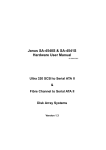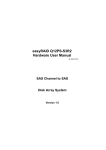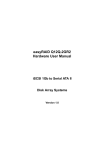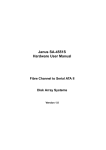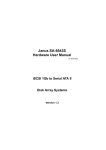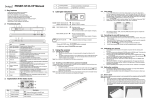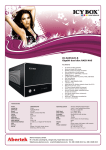Download easyRAID Q16 Hardware User Manual
Transcript
easyRAID Q16 Hardware User Manual Ultra 320 SCSI to Serial ATA & Fibre Channel to Serial ATA Disk Array Systems Version 1.0 ERQ16-U4R3 Ultra 320 SCSI to Serial ATA Disk Array System & ERQ16-F2R3 Fibre Channel to Serial ATA Disk Array System Hardware User Manual Table of Contents Preface................................................................................................................... i Chapter 1 Overview Features ................................................................................................................ 2 Understanding RAID ............................................................................................. 3 NRAID .............................................................................................................. 3 Just a Bunch Of Disks ...................................................................................... 3 RAID Levels ..................................................................................................... 3 Hot Spare Disks ............................................................................................... 6 RAID Combinations .......................................................................................... 6 Summary of RAID Levels ................................................................................. 7 System Requirements ........................................................................................... 8 Operating Environment .................................................................................... 8 VT100 Terminal Settings .................................................................................. 8 Host Interface ................................................................................................... 9 Hard Disks ........................................................................................................ 9 Chapter 2 Basic Configuration Unpacking ........................................................................................................... 11 Components ........................................................................................................ 12 Closed Front Panel ......................................................................................... 12 Open Front Panel ........................................................................................... 13 Disk Tray ........................................................................................................ 14 ERQ16-U4R3 Rear View ................................................................................ 15 ERQ16-F2R3 Rear View ................................................................................ 16 Installing Disks .................................................................................................... 17 Making Connections ........................................................................................... 19 Connecting the Host Interface ........................................................................ 19 Connecting a network ..................................................................................... 21 Connecting and Turning on the Power ........................................................... 22 Mounting in a Rack ............................................................................................. 23 Installing the Rail Extenders ........................................................................... 24 Chapter 3 Maintenance Replacing a Disk ................................................................................................. 25 Replacing a Power Supply .................................................................................. 26 Upgrading Memory ............................................................................................. 28 Appendix Hardware Specifications ..................................................................................... 31 i Preface About this Manual This manual is designed to make the disk array system as easy to use as possible. Information contained in this document has been checked for accuracy, but no guarantee is given that the contents are correct. Information and specifications are subject to change without notice. Copyright Notice © Copyright 2004 All rights reserved. This disk array system and related documentation are protected by copyright and are distributed under licenses restricting their use, copying, and distribution. No part of this documentation may be reproduced in any form by any means without prior written authorization and its licensors, if any. Conventions Caution This symbol is used to remind users to pay attention to important descriptions regarding usage and maintenance (repair) or additional important information related to this disk array system. Note This symbol is used to remind users of useful information that can make procedures such as configuration easier to accomplish. i easyRAID Q16 Serial ATA Disk Array Systems Important Safety Instructions, Care and Handling Preface – Before starting, take a few minutes to read this manual. Read all of these instructions and save this manual for later reference. Protect the disk array system from extremely high or low temperatures. Let the disk array system warm (or cool) to room temperature before using it. Important Safety Instructions, Care and Handling Protect the disk array system from being bumped or dropped. Do not place the disk array system on an unstable cart, stand, or table. It may fall, causing serious damage to the product. Keep the disk array system away from magnetic forces. Do not use the disk array system near water. Keep the disk array system away from dust, sand, or dirt. Gaps and openings in the cabinet are provided for ventilation. Never block or cover these openings, because the disk array system may overheat and become unreliable. Don’t place the disk array system on a bed, sofa, rug, or other similar surface. Do not place the disk array system near or over a radiator or other heat source. V Refer to the rating plate for the correct voltage and ensure that the appliance voltage corresponds to the supply voltage. ii easyRAID Q16 Serial ATA Disk Array Systems The appliance must be grounded. The disk array system is equipped with a 3-wire grounded type of power cord. This power cord will only fit into a grounded type of power outlet. Never push any kind of object into the disk array system through cabinet gaps and openings, since they may touch dangerous voltage points and cause a risk of fire or electric shock. Unplug the power cord from the wall outlet before cleaning. Keep the disk array system dry. Do not use liquid cleaners, aerosol cleaners, or a wet cloth. Use a damp cloth for cleaning. Except as specifically explained in this User Manual, do not attempt to service the disk array system by yourself. Opening or removing the covers may expose you to dangerous voltages. Unplug this product from the wall outlet and refer servicing to qualified service personnel under the following conditions. • If the disk array system has been exposed to water or any liquid. • If the disk array system has been dropped or the cabinet damaged. Users should not remove the cover. oGGwGGY Fan 1 Power 1 Disconnect all power supply cords before servicing. iii Important Safety Instructions, Care and Handling Do not place the disk array system where the cord will be walked on. Preface – If an extension cord or a power center is used with the disk array system, make sure that the total current consumption of all products plugged into the wall outlet does not exceed the ampere rating. easyRAID Q16 Serial ATA Disk Array Systems Placement Notes Preface – Important Safety Instructions, Care and Handling • The disk array system LCD panel can be damaged by exposure to direct sunlight. Limit exposure to subdued or indirect sunlight only. • The disk array system should be used only in clean environments that are free from airborne contaminants such as dust, dirt, and smoke. Excessive moisture or oil particles in the air can also hinder disk array system performance. • To reduce the possibility of data errors caused by electromagnetic interference, locate the disk array system at least five feet away from electrical appliances and equipment that generates magnetic fields. Power Supply Safety Notes • To avoid electric shocks, do not use an extended power cord or an outlet that does not match the disk array system plug or leaves the plug exposed. • The disk array system has a 3-wire grounded plug. The third pin connects to ground; do not remove it. • If the power cord or plug is damaged or worn, unplug it immediately and contact a qualified service technician for maintenance. • To avoid fire or electric shocks, do not overload electric power outlets. iv 1 Overview The disk array system uses groups of inexpensive disks to provide flexibility when balancing data availability, access rate, and capacity management needs. High data availability is achieved by using the fault tolerance features of RAID (Redundant Array of Inexpensive Disks); hot spare disks with automatic on-line rebuild; hot swap disks, and power supplies; independent SATA disk controllers; and dual host controllers. Our confidence in the disk array system is backed by a three year warranty. A high data access rate is achieved by combining the individual data rates of SATA disks in a RAID configuration. SATA disks lack some of the features of SCSI disks but are just as fast when used with a high performance RAID controller. In the disk array system, RAID is controlled by a high performance CPU, which transfers data through dual host interfaces at the maximum possible rate. Flexible data capacity management is achieved with on-line RAID expansion, RAID capacity division into slices, and multiple logical RAIDs. Management is performed through front panel, RJ-45, or RS-232 interfaces. 1 easyRAID Q16 Serial ATA Disk Array Systems Features 1 The main features of the disk array system are listed as follows. Refer to the specifications table on page 31 for more detailed information. Overview – Features • • • • • • • • • • • Operating system independent NRAID, JBOD, RAID 0, 1, 3, 5, 0+1, 30, or 50 array groups On-line expansion Allows division of array groups into slices, each mapped to a LUN Hot spare disk and automatic on-line rebuild Two hot swap power supplies – if one fails, the others take over without interruption Twelve SATA channels Fast 64-bit RISC CPU based RAID controller with up to 1 GB of DDR cache memory. Dual Ultra SCSI (ERQ16-U4R3) or fibre channel (ERQ16-F2R3) host interfaces Audible alarm, disk tray LED, and LCD panel failure indicators Configuration via the front panel or RS-232 interfaces 2 easyRAID Q16 Serial ATA Disk Array Systems Understanding RAID NRAID (Non-RAID) is an array that concatenates the space of all hard disks linearly and forms a large, logical disk. The space presented by the NRAID array starts sequentially from the space of the first member disk to the last member disk without striping, mirroring, or parity. Just a Bunch Of Disks Just a Bunch Of Disks (JBOD) consists of two or more disks that can be different sizes. Disk 1 is completely filled, then disk 2, disk 3, and so on until the final disk is full. The total capacity of JBOD is the sum of the capacities of each disk. Disks are added until the desired total capacity is reached. JBOD is used in the following situations: • Building useful capacity from disks that are too small to be individually useful • Making capacity management easier, since the user only sees one logical disk JBOD doesn’t improve data availability or access rate when compared with a single disk. RAID Levels The overall arrangement of disks in RAID is called the RAID level. Read this section to understand RAID levels. RAID 0 In RAID 0, data is divided into pieces and written to all disks in parallel. This process is called striping because the pieces of data form a stripe across multiple disks. This improves access rate, 3 Overview – Understanding RAID NRAID 1 Read this section to understand how to balance data availability, access rate, and capacity management needs. easyRAID Q16 Serial ATA Disk Array Systems but makes availability lower, since there are more disks and failure of a single disk causes failure of the array. A RAID 0 array is unsuitable for data that can not easily be reproduced, or for data that must be available for critical system operation. 1 RAID 0 consists of two or more disks of equal capacity. The total capacity of RAID 0 is the sum of the capacities of each disk. Disks are added until the desired total capacity is reached. Overview – Understanding RAID A RAID 0 array is useful in the following situations: • Storing program image libraries or run-time libraries for rapid loading. A backup exists because these libraries are usually supplied on read-only media. • Storing large tables or other structures of read-only data for rapid application access. This data should be backed up so that it can be recreated in the event of a failure. • Capturing data from external sources at very high data transfer rates. A RAID 0 array is not useful in the following situations: • Applications that make sequential requests for small amounts of data. These applications spend most of their I/O time waiting for disks to spin, whether or not they use striped arrays. • Applications that make synchronous random requests for small amounts of data. RAID 1 Optional In RAID 1, data is duplicated on two or more disks to provide high access rate and very high data availability. This process is called mirroring. If a disk fails, the RAID controller directs all requests to the surviving members. A RAID 1 array is useful in the following situations: • Availability requirements are very high • High access rate is required • Cost of storage is a secondary issue 4 easyRAID Q16 Serial ATA Disk Array Systems RAID 3 1 RAID 3 consists of two or more disks used for data and one disk used for fault tolerant data. The total capacity of RAID 3 is the sum of the capacities of each data disk. Add disks until the desired capacity is reached, then add one more disk for fault tolerance. RAID 3 is used by the following applications that request large amounts of data sequentially: • Processing of graphical or video images • Processing of CAD/CAM files RAID 3 has the following distinctive features: • Excellent performance for data transfer characteristics • Not well suited for transaction processing or other I/O request intensive applications 5 Overview – Understanding RAID In RAID 3, data is divided into pieces; the parity of these pieces is calculated; and the pieces are written to separate disks in parallel with the writing of the parity to a dedicated disk. This process is called striping with parity. The parity disk stores redundant information about the data on other disks. If a single disk fails, then the data on the other disks is used to regenerate the data on the failed disk. Striping delivers a high access rate and parity delivers good data availability. The single parity disk is a bottleneck on sequential writes, since parity must always be written to the single parity disk. easyRAID Q16 Serial ATA Disk Array Systems RAID 5 1 Overview – Understanding RAID In RAID 5, data is divided into pieces; the parity of these pieces is calculated; and the pieces and parity are written to separate disks in parallel. The parity is written to a different disk each time. Parity provides redundant information about the data on other disks. If a single disk fails, then the data on the other disks is used to regenerate the data on the failed disk. Striping delivers a high access rate and parity delivers good data availability. The bottleneck caused by the single parity disk of RAID 3 is not present in RAID 5, since parity is stored on all disks. RAID 5 consists of two or more disks used for data and one additional disk used for fault tolerence. The total capacity of RAID 5 is the sum of the capacities of each data disk. Add disks until the desired capacity is reached, then add one more disk for fault tolerance. RAID 5 is best used with applications whose data has the following characteristics: • The data is worth protecting, but not as much as RAID 1 • High read data rates • Small proportion of writes to reads Hot Spare Disks A hot spare disk is a standby disk that is not used for data storage unless a RAID member fails. If a disk failure occurs, the failed RAID member is replaced by the hot spare disk without user intervention. This improves data availability, since the RAID is able to tolerate more disk failures with a hot spare disk. RAID Combinations RAID levels may be combined in the following hierarchies: • RAID 0+1 is a RAID 1 consisting of RAID 0 members • RAID 30 is a RAID 0 consisting of RAID 3 members • RAID 50 is a RAID 0 consisting of RAID 5 members 6 easyRAID Q16 Serial ATA Disk Array Systems Summary of RAID Levels The following table summarizes the performance characteristics of each RAID level. A high availability or access rate number indicates high availability or quick access rate. 1 Availability Access Rate Capacity Utilization NRAID 1 1 100% Sum of all disks in the array JBOD 1 1 100% Data is distributed by filling each disk in turn. RAID 0 1 5 100% Data is divided into pieces and written to all disks in parallel. RAID 1 5 2 50% Data is duplicated on both disks. RAID 3 3 3 Between 67% for 3 disks to 94% for 16 disks Data is divided into pieces; the parity of these pieces is calculated; and the pieces are written to separate disks in parallel with the writing of the parity to a dedicated disk. RAID 5 3 3.5 Between 67% for 3 disks to 94% for 16 disks Data is divided into pieces; the parity of these pieces is calculated; and the pieces and parity are written to separate disks in parallel. The parity is written to a different disk each time. RAID 0+1 4.5 5 50% RAID 0+1 is a RAID 1 consisting of RAID 0 members. RAID 30 4 4 Between 67% for 6 disks to 88% for 16 disks RAID 30 is a RAID 0 consisting of RAID 3 members. RAID 50 4 4.5 Between 67% for 6 disks to 88% for 16 disks RAID 50 is a RAID 0 consisting of RAID 5 members. 7 Description Overview – Understanding RAID Array Group easyRAID Q16 Serial ATA Disk Array Systems System Requirements Ensure that the following requirements are met before installing the disk array system. 1 Overview – System Requirements Operating Environment • • • • • 15 cm (6-inches) of space around the disk array system for proper ventilation ambient temperature of 5°C to 40°C (40°F to 104°F) ambient non-condensing relative humidity of 10% to 85% dust, smoke, and oil free environment no large magnetic fields, such as those generated by a high voltage power cables and motors, etc. • no direct sunlight • a flat, stable surface capable of supporting the disk array system VT100 Terminal Settings Refer to the following table for a summary of VT100 terminal settings required to communicate with the disk array system. Refer to your system manual for instructions on setting up the VT100 terminal settings. Item Required Setting Connection Serial Port (COM1 or COM2) Protocol RS232 (Asynchronous) Cabling Null Modem cable Baud Rate 115200 Data Bits 8 Stop Bit 1 Parity None 8 easyRAID Q16 Serial ATA Disk Array Systems Host Interface The disk array system has either dual SCSI interfaces or dual fibre channel interfaces. Refer to the following sections to understand host interface system requirements. 1 The ERQ16-U4R3 has dual Ultra320 SCSI interfaces that are compatible with previous SCSI standards. Refer to the following table to understand SCSI bus requirements. Note Subtract the internal cable length (30 cm) from the maximum SCSI bus length to calculate the maximum external SCSI cable length. SCSI Standard Maximum SCSI Bus Length in Meters Data Rate in Megabytes per Second Maximum Number of Devices Ultra320 12 320 15 Ultra160 12 160 15 Ultra2 12 80 15 Ultra Wide 1.5 40 7 Fast Wide 3 20 15 Ultra 1.5 20 7 Fibre Channel Interface The ERQ16-F2R3 has dual 2 Gbit fibre channel interfaces with SFP connectors for linkage to a fibre channel switch or host computer interface card. With the correct SFP transceiver and optical cable, the following transmission distances can be achieved. Component Optical SFP Transceiver LC Optical Cable Short Wave Long Wave Maximum Cable Length 50m 10 Km Hard Disks Supply the number of SATA disks needed for your application. Refer to “Understanding RAID” on page 3 to determine the number of disks needed. 9 Overview – System Requirements Small Computer Systems Interface 2 Basic Configuration This chapter describes disk array system connections and disk installation. Unpacking Contact your supplier if any of the following items are missing or damaged. Caution The disk array system is heavy. Be careful when lifting and moving it. GUI Installation CD-ROM Front Panel Keys Disk Array System HPD to HPD Ultra320 SCSI HPD to VHDC Ultra320 SCSI Terminator (ERQ16-U4R3 Only) Cable (ERQ16-U4R3 Only) Cable (ERQ16-U4R3 Only) TA lA A AT 30 Serial -72 SI to SAtra320 SC Ul A AT & 231l to Serial -7 ne SAre Chan Dis k Arr ay Sy ste m Fib k Arr ay Sy ste m re rdwa Ha er Us l ua Man 0 Seria 23 to -7 SCSI TA lA SUAltra320 1 Seria & 723el to - hann SFiAbre C Di sk Ar ra y Sy ste Di m sk Ar ra y Sy ste e ar dw ar H l ua an rM se U m Dis Fix Screw Pack M5 Screw pack Hardware and software user Manuals Power Cables Fix Screw Pack UNC #10~32 RS-232 Cable Rails Rail Extenders 11 easyRAID Q16 Serial ATA Disk Array Systems Components 2 Basic Configuration – Components Closed Front Panel 2 3 4 9 1 No. 5 6 7 8 Name Description 1 LCD panel Displays warning, operating, and configuration information. 2 Power-on indicator Indicates the disk array system power is on. 3 Power supply fail indicator Indicates a failed power supply. 4 Host computer access indicator Indicates data transfer between the disk array system and the host computer. 5 Up function button Moves up in the LCD menus. 6 Down function button Moves down in the LCD menus. 7 Enter function button Selects a menu item or confirms a choice or entry. 8 Escape function button Returns to the previous LCD menu without making changes. 9 Front panel door lock Secures the front panel door. 12 easyRAID Q16 Serial ATA Disk Array Systems Open Front Panel 5 6 7 8 9 10 1112 13 14 15 16 2 1 2 3 4 Basic Configuration – Components 17 No. Name Description 1-16 Disk trays 1 to 16 Removable hot swap disk trays. 17 Front panel door Protects the disks and houses the LCD Panel. 13 easyRAID Q16 Serial ATA Disk Array Systems Disk Tray 2 Basic Configuration – Components Front 4 2 1 3 No. Name Power/Error indicator LED Description Different colors indicate different disk states: • Green – Disk online • Orange – Disk full • Red – No disk 1 Indicates that the disk is being accessed. 2 Access indicator LED 3 Tray handle Releases the disk tray. 4 Push Button Push the button to release the Disk tray handle. • Blue 14 – Disk access easyRAID Q16 Serial ATA Disk Array Systems ERQ16-U4R3 Rear View 2 3 4 Term 15 14 13 No. 12 Host Port 1 MODEM 11 UPS 10 9 Name 8 7 6 5 Description 1 Cooling fan 1 System cooling fan 2 Host Port 2 (Secondary SCSI channel) Connects to the host server. 3 Host Port 1 (Primary SCSI channel) Connects to the host server. 4 Cooling fan 2 System cooling fan 5 Power Supply AC In Connects to a 100-240 VAC power source. 6 Power Supply 2 Removable redundant power supply 2. 7 Power Supply Handle For power supply removal 8 Power Supply Switch Switches the power on or off. 9 UPS port Data port for uninterruptable power supply 10 Modem Port Connects to a modem for sending remote alerts. 11 RS-232 Port Connects to a VT100 terminal or equivalent. 12 Ethernet Port Used for browser-based configuration. 13 Power Supply AC In Connects to a 100-240 VAC power source. 14 Power Supply 1 Removable redundant power supply 1. 15 Power Supply Handle For power supply removal 15 Basic Configuration – Components Host Port 2 2 1 easyRAID Q16 Serial ATA Disk Array Systems ERQ16-F2R3 Rear View 2 2 Basic Configuration – Components 1 3 Term 16 15 No. 14 13 12 4 5 MODEM UPS 11 10 9 Name 8 7 6 Description 1 Cooling fan 1 System cooling fan 2 Port select switch Selects speed for host ports 1 and 2: • Up – • Down – 2 Gbps 1 Gbps 3 Host Port 1 (Primary fibre channel) Connects to the host server. 4 Host Port 2 (Secondary fibre channel) Connects to the host server. 5 Cooling fan 2 System cooling fan 6 Power Supply AC In Connects to a 100-240 VAC power source. 7 Power Supply 2 Removable redundant power supply 2. 8 Power Supply Handle For power supply removal 9 Power Supply Switch Switches the power on or off. 10 UPS port Data port for uninterruptable power supply 11 Modem Port Connects to a modem for sending remote alerts. 12 RS-232 Port Connects to a VT100 terminal or equivalent. 13 Ethernet Port Used for browser-based configuration. 14 Power Supply AC In Connects to a 100-240 VAC power source. 15 Power Supply 1 Removable redundant power supply 1. 16 Power Supply Handle For power supply removal 16 easyRAID Q16 Serial ATA Disk Array Systems Installing Disks 2 Push the button (A) to release the disk tray handle. Pull the handle (B) to release the tray. A B 3 Align the rear of the disk with the rear of the disk tray. 4 Insert the disk into the disk tray and fix into place with screws supplied with the disk. 17 Basic Configuration – Installing Disks 1 Unlock the front panel door, then pull it open. 2 This section describes how to install disks in the disk array system. Read “Understanding RAID” on page 3 to decide how many disks are required. easyRAID Q16 Serial ATA Disk Array Systems 5 Slide the disk tray back into the empty slot (A), then slowly close the disk tray handle (B). 2 Basic Configuration – Installing Disks B A 6 Repeat steps 2 to 5 until all of the required disks have been installed. 7 Push the front panel door closed, and lock it. 18 easyRAID Q16 Serial ATA Disk Array Systems Making Connections The disk array system has either dual SCSI interfaces or dual fibre channel interfaces. Refer to the following sections to make host interface connections. Small Computer Systems Interface The ERQ16-U4R3 has dual Ultra320 SCSI interfaces. Follow these instructions to make connections. 1 Connect the SCSI terminator (A) to the bottom connector of the ERQ16-U4R3 host port 1 (primary SCSI channel) at the rear of the disk array system. A B oGGwGGY Fan 1 Power 1 Fan 1 Power 1 2 Connect the Ultra320 SCSI cable (B) to the top connector of the ERQ16-U4R3 host port 1 (primary SCSI channel) at the rear of the disk array system. 19 Basic Configuration – Making Connections Connecting the Host Interface 2 After the required number of disks have been installed, external connections to the disk array system must be made. This section describes how to make all of the necessary connections. easyRAID Q16 Serial ATA Disk Array Systems Fibre Channel Interface 2 Basic Configuration – Making Connections The ERQ16-F2R3 has dual 2 Gbit fibre channel interfaces. Each interface can be used with optical or copper transceivers and cables. Follow these instructions to make optical connections. 1 Insert fibre cable into the ERQ16-F2R3 host port 1 (primary fibre channel) at the rear of the disk array system. Fan 1 Power Fibre Channel Daisy Chaining Four-port models can be daisy chained as shown in the following diagram. Term MODEM UPS Term MODEM UPS Term MODEM UPS 20 1 easyRAID Q16 Serial ATA Disk Array Systems Connecting a network Connect the network cable to the RJ-45 port at the rear of the unit. 2 21 1 Basic Configuration – Making Connections Fan 1 Power easyRAID Q16 Serial ATA Disk Array Systems Connecting and Turning on the Power 1 Plug a power cable (A) to a power connector at the rear of the unit, then plug the second power supply cable into the second power connector (B). 2 Basic Configuration – Making Connections Note The system is equipped with auto switching power supplies that can run on 100 to 240 VAC. Fan 1 Power B 1 A 2 Switch on both power supplies. 22 easyRAID Q16 Serial ATA Disk Array Systems Mounting in a Rack You will need four nuts and bolts (not included) for each rail; two at the front and two at the back. 4 Tighten the locking screws when they are the correct length. 5 Slide the disk array system into the rack and bolt it into place with the supplied fixing screws. Caution This product is heavy. Attempting to install the disk array system in a rack by yourself could result in injury or damage to the product. 23 Basic Configuration – Mounting in a Rack 1 Clip eight rack nuts supplied with your rack, into the rack, taking care that they correspond with the mounting points on the rails. 2 Extend both of the rails so that they are the right length to fit in your rack. 3 Bolt the rails into the rack using the rack bolts supplied with your rack. 2 When the disk array system is completely set up, it can be installed in a standard 19-inch rack. Follow the instructions in this section to install the disk array system in a rack. easyRAID Q16 Serial ATA Disk Array Systems Installing the Rail Extenders Follow these instructions to fit the rail extenders if required. 2 Basic Configuration – Mounting in a Rack 1 If required, bolt the rail extenders into place as shown using the small bolts provided. 2 Slide the disk array system into the rack and bolt it into place with the supplied fixing screws. Note The rail extenders may be required to allow the disk array system room for the front door to open correctly. 24 Chap3.fm Page 25 Thursday, September 29, 2005 10:52 AM 3 Maintenance Replacing a Disk A disk failure is indicated when the Power/Error LED at the front of the drive tray turns red and the audible alert sounds. Note Turn off the audible alert by pressing the Up and Down tons on the front panel twice simultaneously. function but- The LCD panel displays the failure with the symbol “R” or “W”. “R” indicates a disk failure or error, and “W” indicates that there are too many bad sectors on the disk. 1111122222WR Example: • Disks 1 to 5 are members of array group 1. • Disks 6 to 10 are members of array group 2. • Disk 11 has too many bad sectors. • Disk 12 has an error or a fault. Disks are hot swappable, which means that they can be inserted and removed while the disk array system is powered on and operating. Follow these instructions to replace a failed disk. 1 2 3 4 Unlock the front panel door, then pull it open. Pull the tray handle away from the disk tray to release it; and pull the disk tray out. Remove the screws from the failed disk, then remove the disk from the disk tray. Align the rear of the new disk with the rear of the disk tray. 5 Insert the new disk into the disk tray. Note The new disk must have the same or a greater capacity than the faulty disk that was removed. If the disk capacity is smaller, the audible alert sounds and the auto-rebuild operation doesn’t start. For best performance, it is recommended that the new disk be identical to the failed disk. 6 Attach the disk to the disk tray with the screws that came with the disk. 7 Slide the disk tray back into the empty slot, then close the disk tray handle. 8 Push the front panel door closed, and lock it. 25 Chap3.fm Page 26 Thursday, September 29, 2005 10:52 AM easyRAID Q16 Serial ATA Disk Array Systems Replacing a Power Supply 3 Maintenance – Replacing a Power Supply The disk array system is equipped with a Power Supply Fail Indicator LED at the front of the unit that turns red when one of the power supplies fails. The message “Power x failure” also appears on the LCD panel, where x refers to power supply 1, or 2, and an audible alert sounds. Note Turn off the audible alert by pressing the Up and Down tons on the front panel twice simultaneously. function but- Power supplies are hot swappable, which means that they can be inserted and removed while the disk array is powered on and operating. Follow these instructions to replace a failed power supply. 1 Identify the power supply that has failed. Host Port 2 Term Host Port 1 MODEM UPS Power Supply 1 Power Supply 2 2 Remove the power cable from the power supply connector at the rear of the unit. Note The system is equipped with auto switching power supplies that can run on 100 to 240 VAC. 3 Loosen the power supply retaining screw. oGGwGGY Fan 1 Power 1 26 Chap3.fm Page 27 Thursday, September 29, 2005 10:52 AM easyRAID Q16 Serial ATA Disk Array Systems 4 Pull the power supply handle out. oGGwGGY 3 1 5 Remove the faulty power supply by pulling the power supply handle and pressing the release catch. oGGwGGY Fan 1 Power 1 Release catch 6 Insert a new power supply. oGGwGGY Fan 1 Power 1 7 Push the power supply handle into place. 8 Tighten the power supply thumbscrew. oGGwGGY Fan 1 Power 9 Reconnect the power cable. 27 1 Maintenance – Replacing a Power Supply Fan 1 Power Chap3.fm Page 28 Thursday, September 29, 2005 10:52 AM easyRAID Q16 Serial ATA Disk Array Systems Upgrading Memory 3 The disk array system takes a single 200 pin PC200 DDR SDRAM SO-DIMM with a maximum capacity of 1 GB. Follow these instructions to upgrade the memory. Maintenance – Upgrading Memory 1 Loosen the screws holding the controller cage in place. 2 Lift the handle and slide the controller-cage out of the chassis. oGGwGGY oGGwGGY Fan 1 Power Fan 1 Power 1 1 3 Carefully remove the cables from the daughter board, remove the three screws, and lift it away from the array group controller. Daughterboard Array group controller 4 Pull the DIMM retaining clips away from the DIMM; the DIMM springs out of the socket. Remove the DIMM. 28 Chap3.fm Page 29 Thursday, September 29, 2005 10:52 AM easyRAID Q16 Serial ATA Disk Array Systems 5 Gently push the new DIMM into the socket at 45 degrees, then push the corners of the DIMM down. The DIMM is secured by the DIMM retaining clips. 3 The DIMM module will fit in only one direction. Do not force the DIMM into place. 6 Replace the daughter board on the array group controller, taking care to align the connectors. 7 Push the disk controller back in, lower the handle, and tighten the retaining screws. oGGwGGY oGGwGGY Fan 1 Power Fan 1 Power 1 29 1 Maintenance – Upgrading Memory Note Chap3.fm Page 30 Thursday, September 29, 2005 10:52 AM Appendix Hardware Specifications Item Specification Host Interface SCSI Ultra320 (ERQ16-U4R3) or Fibre Channel (ERQ16-F2R3) Disk Interface 16 x SATA, 150 MB/s Dimensions 132 mm (H) x 446 mm (W) x 574 mm (D) Weight 25 Kg without disks RAID Functions • • • • Raid levels: 0, 1, 0+1, 3, 5, 30, 50, JBOD, or NRAID Hot spare support Disk hot swapping with automatic online rebuilding Multiple RAID (max. 8) Disk Array Functions • • • • • • O/S independent and transparent 64 MB ~ 1 GB DDR SDRAM LCD panel operation indicator Audible alarm/disable alarm Optional battery backup for disk array status LED indicator on disk failures Connectors • • • • 4 x 2-Gbit Fibre ports (2 channels), ERQ16-U4R3 model only 4 x Ultra320 SCSI ports(2 channels), ERQ16-F2R3 model only 1 x RS-232 Serial port (115200, n, 8, 1) 1 x RJ-45 Ethernet port (10/100 Mbps) Power Supply • • • • • • • Redundant 1 + 1, 460Watt 100 - 240 VAC, 47-63 Hz, 6~3A +/- 10% Over voltage, current, power, and short circuit protection LED indicates power status Operating temperature: 0°C ~ 50°C Operating humidity: 20 ~ 90% Output: +5V, +3.3V, +12V Warranty 3 year warranty Safety UL, CE and FCC Class B 31 easyRAID Q16 Serial ATA Disk Array Systems Item Controller Appendix – Hardware Specifications Backplane Specification CPU Intel i80321 64-bit RISC microprocessor Disk Interface Serial ATA I Disk Channels 16 channels Disk Interface Chipset Marvell MV88SX8050 Memory Type PC200 DDR 200-pin SO-DIMM Memory Sockets 1 Memory Size Up to 1 GB LCD Interface One LCD panel, 2 lines by 16 characters Button Interface Up, Down, Enter, and ESC Battery Backup Interface Yes Daughter Board Interface PCI-X 64-bit, 66/133MHz Backplane Interface (connector) Compact-PCI Disk Channel Support 16 channels Disk Number Supported 16 disks Disk Connector Type Serial ATA 1 Temperature Sensors 8 Power Connector Type 2 x Slot-2 Fan Connector Type 2 x Slot-2 32














































